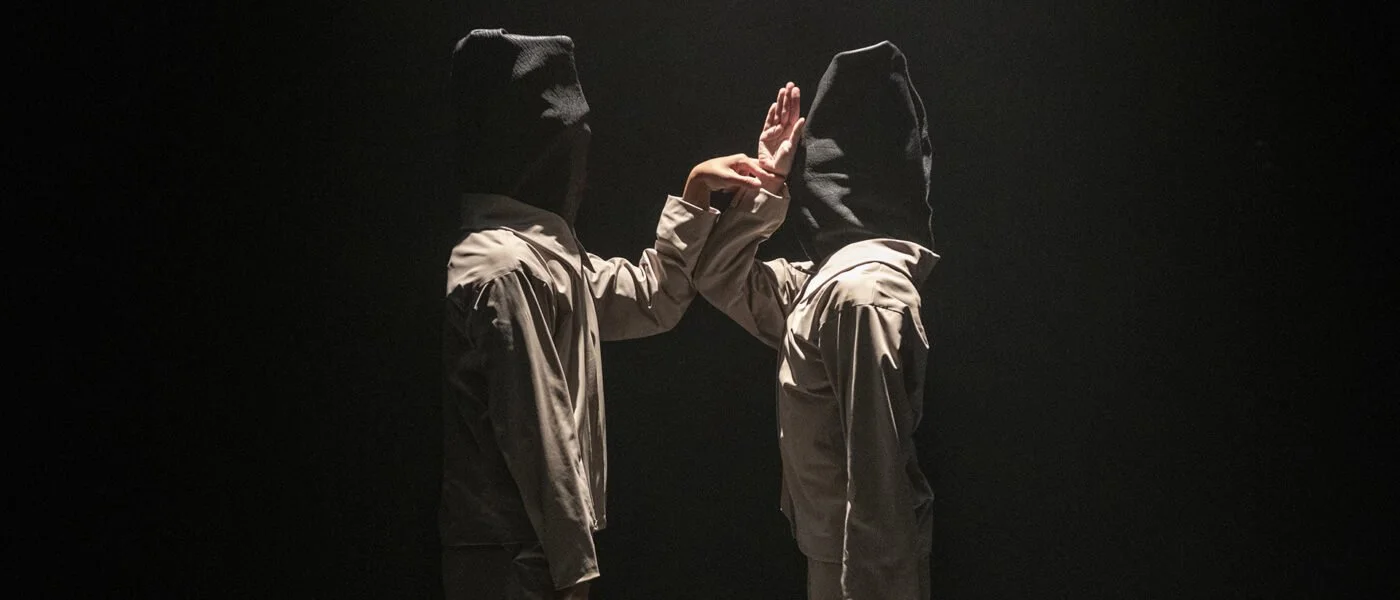Wearing leather hoods, dancers learn to "see without seeing" in FakeKnot's whip
In daring duet at Vancouver International Dance Festival, choreographer Ralph Escamillan explores the limits of trust with Daria Mikhaylyuk
FakeKnot’s whip. Photo by David Wong
Vancouver International Dance Festival presents whip at the Roundhouse Performance Centre from February 28 to March 2
FOR THE 60-MINUTE duration of FakeKnot’s whip, dancers Ralph Escamillan and Daria Mikhaylyuk can’t see. That’s because they’re wearing leather hoods, created by Vancouver-based Five Left designer Lincoln Heller—head coverings that unfold and elongate, the performers whipping them around.
“It’s really intense to be in there 60 minutes,” admits Escamillan, who also choreographed the work. “If we need to come out of it, we allow that to be okay and be part of work. But that hasn't happened yet.”
Premiered in 2021 at MAI (Montréal, Arts Interculturels), the finished work is finally making its way back to choreographer Escamillan’s hometown, showing at the Vancouver International Dance Festival.
Its creation traces back long before the pandemic, when a young, fashion-minded Escamillan, still in high school, spotted a chic leather bag, designed by Heller, that Vancouver dance artist Justine A. Chambers had toted to a studio. Escamillan’s mother ended up buying him his own Five Left bag as a high-school graduation present—eventually leading to several fashion collaborations.
Whip grew out of the exploration of the duality of leather as both soft and hard. “What is leather? How do we make it move?” Escamillan asks. “It was also: How can a costume be not just something on the body?” The foldability of the hoods played beautifully into ideas of transformation. The head whipping? Escamillan has been inspired by everything from clips of Japanese kabuki performers throwing around their long wigs to the hair-whipping of the voguing scene, where Escamillan is prominent in local ballroom culture. (He’s a founder of the nonprofit VanVogueJam—which happens to also be hosting a Super Kiki Ball on March 3.)
“Something I was really aware of is we were never interested in re-creating being blind,” Escamillan stresses about the hoods. “It was more about how we created the environment to move in, and trusting each other.”
Escamillan says he and Mikhaylyuk created the piece without the hoods. Learning how to see without seeing, they came up with a complex system of delineating space using tape, and using the four speakers of quadraphonic sound as a kind of compass. “The rest of it is trusting we know where we are in space and trusting each other,” the artist explains.
Anyone familiar with Escamillan’s work with FakeKnot knows he likes to set himself physical and sensory restrictions, often impairing his sightlines. In HINKYPUNK, he sported a glittery bodysuit that also pulled up to covered his entire face. In the recent PIÑA, fabric sometimes completely enveloped dancers, and there was an entire section performed in black light.
“I’m really good at dancing without sight,” Escamillan reflects matter-of-factly. “I guess what gravitates me toward not seeing is there’s an element of circus to it—there's a risk factor that adds intrigue as a viewer. It pushes you to anchor into the physical body more, and pushes you into where you are in the space. I definitely have a way of being that I found through this work. It’s kind of freeing. Then there’s this idea of masks. And not having to worry about the audience.”
That helps with some of the more intimate moments of contact in Escamillan’s work—touching and connection between the pair’s bodies that “we wouldn't be able to do if we weren’t masked”.
Escamillan isn’t a member of the fetish community, though he sees his queer-nightlife and vogue scenes as running adjacent to that world. But recognizing some of the associations with the leather hoods, he says he “leaned into” the fetish-kink culture overtones of the costumes. And that led into deeper themes of consent.
“There’s a lot of conversation about consent in the dance world,” he begins. “And in the fetish community is actually one of the most consent-minded communities out there. So it’s interesting that they have consent while the rest of the world is trying to learn about consent.”
And so there are multiple layers of enjoyment to watching whip. There’s the sheer feat of dancing without sight, even moving in unison at some points, under a stark row of PAR lights from above. Then there are the multiple ways the work explores transformation and trust between people. And then there’s just the sheer wonder at the way Escamillan, over years, has taken a favourite high-school bag and turned it into something so striking and complex. ![]()














